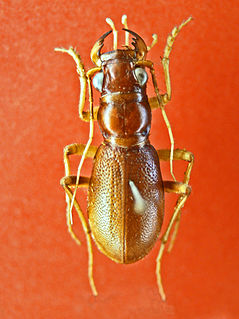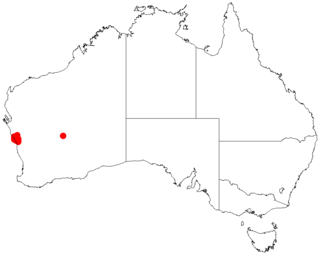Related Research Articles

The poplar grey is a moth of the family Noctuidae. It is found throughout Europe.

Chrysomya putoria, also known as the tropical African latrine blowfly, is a fly species belonging to the blowfly family, Calliphoridae.C. putoria is native to Africa and has recently spread to the Americas. These flies pose significant health risks, especially due to their close association with human settlements. Adult flies can carry pathogens, while larvae may cause myiasis by growing and feeding on the flesh of domestic animals and humans. Other myiasis-causing flies in the same genus are C. bezziana and C. megacephala. C. putoria and other flies that feed on decomposing tissue are used as important tools in forensic entomology to establish the post-mortem interval, or the time elapsed since death.

Chrysomya is an Old World blow fly genus of the family Calliphoridae. The genus Chrysomya contains a number of species including Chrysomya rufifacies and Chrysomya megacephala. The term “Old World blow fly” is a derivative of both the associated family, Calliphoridae, and the belief that the genus Chrysomya originated in Asia and migrated to North America only relatively recently. Chrysomya’s primary importance to the field of medico-criminal forensic entomology is due to the genus’ reliable life cycle, allowing investigators to accurately develop a postmortem interval. Chrysomya adults are typically metallic colored with thick setae on the meron and plumose arista. The name comes from the word chrysos, meaning “golden” in reference to the metallic sheen of the genus’ species, and -mya, a derivation from the word myia, meaning “fly”.

Regelia is a genus of flowering plants in the family Myrtaceae and is endemic to the south-west of Western Australia. The genus is composed of five species of small leaved, evergreen shrubs which have heads of flowers on the ends of branches which continue to grow after flowering. Another species, previously known as Regelia punicea and which is endemic to Kakadu National Park in the Northern Territory, has been transferred to Melaleuca punicea.
Pseudolechriops is a genus of Central American weevils alternatively placed in the subfamily Conoderinae or Baridinae. Established by the English entomologist George Charles Champion in 1906, the genus contained only one species, P. megacephala, until several related species were described in 2005.

Chrysomya megacephala, more commonly known as the oriental latrine fly, is a member of the family Calliphoridae (blowflies). It is a warm-weather fly with a greenish-blue metallic box-like body. The fly infests corpses soon after death, making it important to forensic science. This fly is implicated in some public health issues; it can cause accidental myiasis, and also infects fish and livestock.
Ulidia megacephala is a species of ulidiid or picture-winged fly in the genus Ulidia of the family Tephritidae.

Pheidole megacephala is a species of ant in the family Formicidae. It is commonly known as the big-headed ant in the USA and the coastal brown ant in Australia. It is a very successful invasive species and is considered a danger to native ants in Australia and other places. It has been nominated as one of the hundred "World's worst" invaders.

Megacephala is a small genus of beetles in the family Carabidae restricted to Africa; it was formerly a much larger genus, but its constituent species have been subsequently placed in other genera, primarily Tetracha, but also Grammognatha, Metriocheila, Phaeoxantha, and Pseudotetracha.
Joculator megacephala is a species of minute sea snail, a marine gastropod mollusc in the family Cerithiopsidae. The species was described by Jay and Drivas in 2002.

Megacephala megacephala, common name big-headed tiger beetle, is a species of tiger beetle in the subfamily Cicindelinae that was described by Olivier in 1790.
Pheidole megatron is a species of ant in the subfamily Myrmicinae.
Pheidole decepticon is a species of ant in the subfamily Myrmicinae.

Regelia megacephala is a plant in the myrtle family, Myrtaceae and is endemic to the south-west of Western Australia. It is a taller shrub than others in its genus, with small, rounded leaves and clusters of purplish-red flowers from October to December.

Melaleuca megacephala is a plant in the myrtle family Myrtaceae and is native to the south-west of Western Australia. It is distinguished by its large, hemispherical heads of yellow and white flowers on the ends of the branches and the overlapping brown bracts under them.

Acacia megacephala is a shrub of the genus Acacia and the subgenus Pulchellae that is endemic to south western Australia.
Olivensa cephalotes is a species of beetle in the family Cerambycidae. It was described by Francis Polkinghorne Pascoe in 1858. It is known from Brazil, Ecuador and French Guiana.
Olivensa mimula is a species of beetle in the family Cerambycidae. It was described by Lane in 1965. It is known from Brazil and Colombia.
Megophrys megacephala is a species of frog in the family Megophryidae from East Khasi Hills District, Meghalaya, India.
Phaeoxantha is a genus of tiger beetles in the family Carabidae, formerly included within the genus Megacephala.
References
- ↑ BioLib.cz - Olivensa megacephala. Retrieved on 8 September 2014.